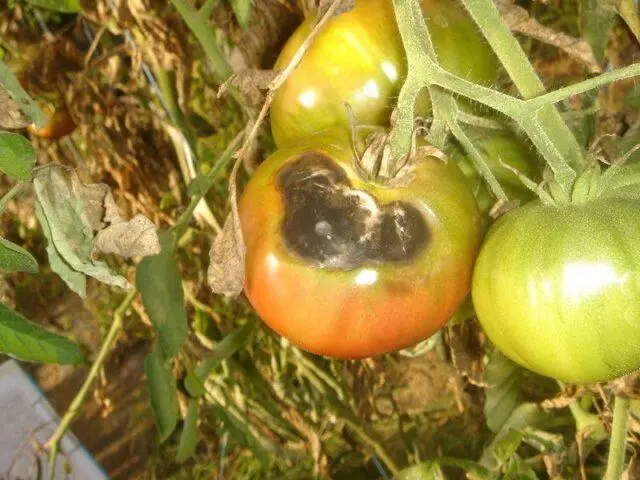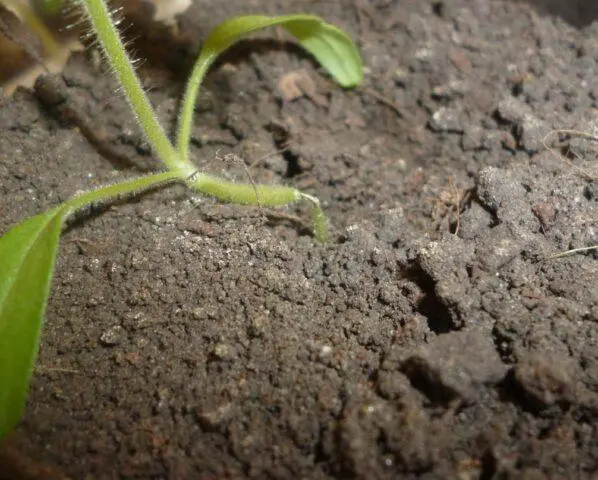Contents
The Japanese dwarf tomato is a hardy early-ripening tomato variety with good yields. Before planting a crop in a garden or greenhouse, you need to carefully study the features and requirements for growing.
The story of
The history of the origin of the Japanese dwarf tomato cannot be traced reliably. It is only known that the variety is not directly related to Japan, and its originators are breeders from Kazakhstan.
The variety has been on the market for a long time, the Invent Plus company is engaged in the production of seeds. The variety is not often found in stores, but for the constant cultivation of the Japanese dwarf tomato on the site, you do not need to buy new planting material every year. You can use seeds self-collected from tomatoes grown in the previous season.
Description of the variety of tomato Japanese dwarf
Japanese dwarf is a determinate tomato variety with an early yield. As the name suggests, it is short in stature. Dwarf bushes rise up to a maximum of 50 cm above the ground. The plant is spreading and densely leafy. The stems of the tomato are thick and strong, small dark green plates have a standard shape for the culture and do not have pubescence.
Variety Japanese dwarf brings simple inflorescences, the first of which is formed in the axil of 5-6 leaves, and the subsequent ones go through the leaf. Tomatoes are collected in compact brushes up to five pieces on each.

Tomato Japanese dwarf has a sweet taste with barely noticeable sourness
The Japanese dwarf bears medium-sized fruits up to 50-70 g by weight. In rare cases, one tomato can weigh about 100 g. The fruits are round and slightly flattened at the base, weakly pronounced ribs are also visible in the lower part, a light green spot may be present. The skin of the tomatoes is red, like the pulp, the structure is tender and juicy, each of the tomatoes contains 4-5 chambers with a few seeds.
The fruits of the Japanese dwarf are distinguished by good keeping quality and do not crack. They can be stored for 3-4 weeks at low temperatures, tomatoes are suitable for long-term transportation.
Variety Japanese dwarf shows good endurance, develops when planted in the sun and in moderate shade. Suitable for cultivation in greenhouses, in the open field and even in flowerpots. Requires support, but due to its low growth does not create difficulties in its installation.
Characteristics of the tomato Japanese dwarf
Before planting a tomato on the site, it is necessary to study its main characteristics. In general, the variety is considered quite profitable for breeding.
Yield and fruiting period
The Japanese dwarf belongs to the early ripening tomatoes and bears fruit on average 85-95 days after the formation of the first green shoots. Tomatoes on the shoots ripen together, the collection can be carried out at the same time, usually suitable dates come at the end of June.
Tomato yields are average. One adult bush in good conditions brings up to 2 kg of fruit. Considering that for 1 m2 you can plant 5-9 plants, even in a small area it is really possible to harvest a good harvest.
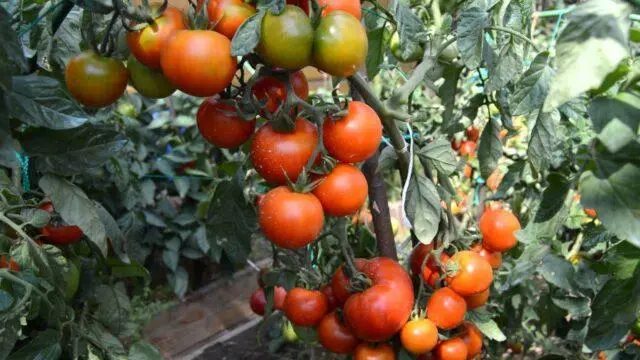
Tomatoes Japanese dwarf are easily separated from the stems along with the stalk
Disease and pest resistance
Variety Japanese dwarf has an average immunity to diseases and pests. Tomatoes suffer from fungal infections typical of the culture – bacteriosis, root rot, mosaic. But bushes are rarely affected by late blight, since the disease usually manifests itself in the second half of summer, while the Japanese dwarf finishes fruiting earlier.
Methods of Use
The Japanese dwarf belongs to the universal varieties. Sweet and sour tomatoes can be eaten fresh and added to salads, squeezed to get healthy juice. The fruits are stewed and baked as part of meat and vegetable dishes. Due to its compact size and dense skin, the Japanese dwarf is well suited for conservation in its entirety.
Advantages and disadvantages
Before planting a Japanese dwarf tomato on the site, you need to familiarize yourself with the strengths and weaknesses of the variety.
Pros: · endurance; · early fruiting; · good productivity; not afraid of temperature changes; suitable for open ground and greenhouses; Not affected by phytophthora; Grows in shady areas of the garden. | Cons: suffers from root rot and viruses; · Needs pinching. |
Features of planting and care
The rules for planting and caring for the Japanese dwarf tomato are quite standard. The variety is grown through seedlings according to the following algorithm:
- In early spring, seeds are sown at intervals of 2 cm in nutritious moist soil in wide boxes.
- Sprinkle the material on top with soil and cover with a film.
- Germinate at a temperature of about 25 ° C until seedlings form.
- When green sprouts appear, remove the film and rearrange the box in a well-lit place.
Before being transferred to open ground, the Japanese dwarf is watered with warm water under the root, and when real leaves appear, they dive.
About 14 days before transplanting into the soil, tomatoes begin to harden. To do this, they are taken out into the fresh air – first for a short time, and then for a full day. Seedlings are transferred to the ground from late April to early June. The beds for culture are prepared in the fall, the earth is dug up and humus is introduced, and in the spring they are re-loosened.
It is necessary to plant a tomato in a checkerboard pattern according to the 50×50 scheme – this allows you to place up to 5-9 plants per meter of the garden. In the process of transferring to the ground, a little wood ash is added to each of the holes. After planting, the bushes are properly watered.
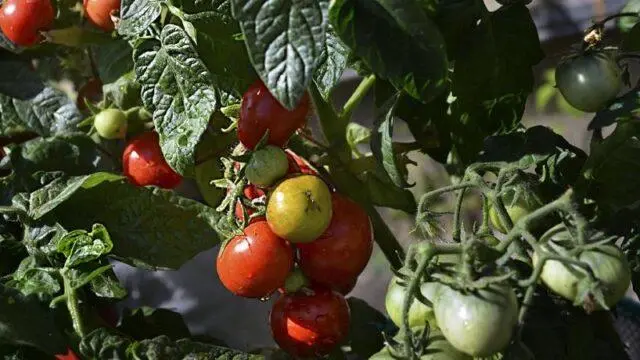
When planted closely on the site, the Japanese dwarf tomato bears less abundant fruit
Japanese dwarf tomato care is carried out according to standard algorithms. Attention needs to be paid to:
- watering – moisture is introduced as the soil dries up, 1,5-2 liters of water under the bush;
- top dressing – the tomato is fertilized three times per season, alternating organics and complex minerals;
- pinching – after the beginning of flowering of the first brush, it is necessary to remove all the shoots located below;
- weeding – weeds take away nutrients from the Japanese dwarf and worsen the quality of fruiting.
It is not necessary to tie up a low-growing tomato variety, but it is desirable. Installing a support prevents the fruit from lodging on the ground and reduces the risk of developing fungal diseases in the plant.
Pest and disease control
The Japanese dwarf does not suffer from late blight, but may be affected by other ailments. Among them:
- bacteriosis, or rotting of the stem, – the lower leaves of the bushes turn yellow, mucus appears on the cut of the shoot;

To prevent bacteriosis, the seeds are treated before sowing in potassium permanganate or Bactofit solution.
- alternariosis – small brown spots appear on the plates and fruits;

In the initial stages of alternariosis, spraying with Trichodermin helps
- black leg – the lower part of the stem and roots die off at the tomato.

The black leg develops in conditions of excessive moisture.
Of the pests for tomatoes, aphids are the most dangerous. It tightly covers the plates of bushes growing in open ground, and sucks the juices out of them, preventing the formation of ovaries.
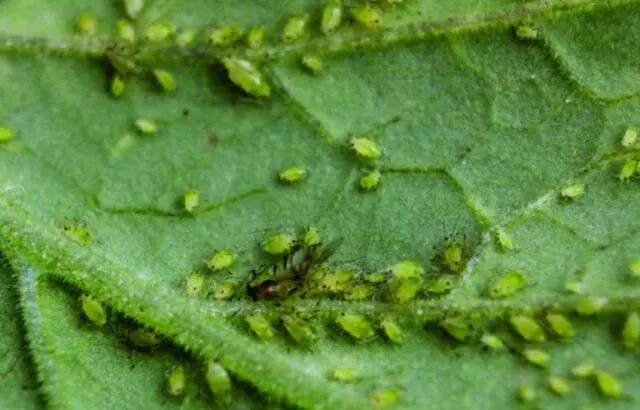
A solution of laundry soap helps well against aphids on tomatoes
Preventively, tomatoes can be protected from diseases by regularly loosening and cleaning the beds from plant debris. Before sowing seedlings, seeds are recommended to be treated in a weak solution of potassium permanganate to increase endurance.
Conclusion
Japanese dwarf tomato is characterized by unpretentiousness, productivity and good taste. The variety is suitable for growing in open ground outside the greenhouse, calmly tolerates cold snaps and has strong immunity.











